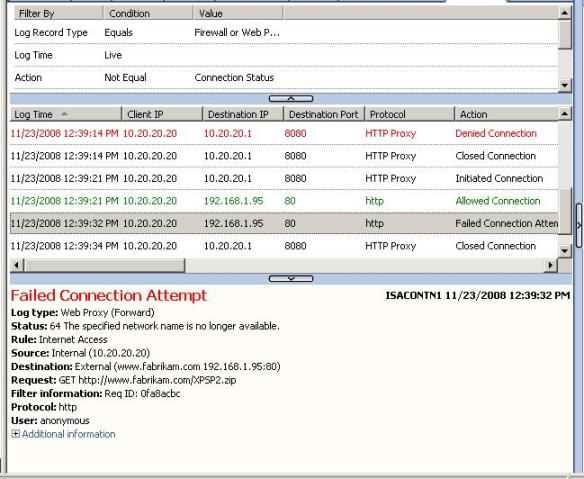Error 64 “ The specified network name is no longer available” while browsing Internet through ISA Server 2006
1. Another error 64?
After posting one of the reasons why ISA Server 2006 can come up with the generic error 64 in one of my posts, some readers asked me if this is the ultimate reason for this error. The answer is: it is not! Since the error 64 is generic it needs to be carefully interpreted, my previous post about this error mentions the “error 64” with the message: “host not available”.
This post will explain in more details why the error message below showed in the ISA Server 2006 Logging could occur while you are browsing Internet.

Figure 1 – Another error 64.
The error above was caught while the user was trying to browse www.fabrikam.com and download the Windows XP SP2 file. To simulate this problem I used the following lab:

Figure 2 – Lab used to simulate this problem.
2. Understanding the nature of this error
The 64: "The specified network name is no longer available" is a win32 error originally called ERROR_NETNAME_DELETED, this error is mapped in the winerror.h as:
//
// MessageId: ERROR_NETNAME_DELETED
//
// MessageText:
//
// The specified network name is no longer available.
//
In the network level, this problem could be cause by:
Network connectivity problems have various causes, but they typically occur because of incorrect network adapters, incorrect switch settings, faulty hardware, or driver issues. Some connectivity symptoms are intermittent and do not clearly point to any one of these causes.
Per KB325487.
Which means that is more under the TCP/IP level, which is controlled by the Windows OS rather than ISA Server itself.
3. Simulating the Problem
To simulate this problem I used a tool called Network Emulator for Windows and added high latency and random packet loss. Besides I also used the Web Application Stress Tool to add more load to my web server and really simulate a situation where server is busy. Now let’s take a look in the netmon trace got from the external interface of the ISA Server:
ISA Server sends the HTTP GET for the destination server:
12:39:13.355 192.168.1.113 192.168.1.95 HTTP HTTP:Request, GET /
- Http: Request, GET /
Command: GET
+ URI: /
ProtocolVersion: HTTP/1.1
Via: 1.1 ISACONTN1
If-None-Match: "304054985f13c91:4b2"
UserAgent: Mozilla/4.0 (compatible; MSIE 6.0; Windows NT 5.2; SV1; .NET CLR 1.1.4322)
Host: www.fabrikam.com
If-Modified-Since: Wed, 10 Sep 2008 16:09:25 GMT
Accept: image/gif, image/x-xbitmap, image/jpeg, image/pjpeg, */*
Accept-Language: en-us
UA-CPU: x86
Connection: Keep-Alive
HeaderEnd: CRLF
Destination server sends the answer:
12:39:13.745 192.168.1.95 192.168.1.113 HTTP HTTP:Response, HTTP/1.1, Status Code = 200, URL: /
A HTTP GET is sent to get the XP SP2 file:
12:39:31.751 192.168.1.113 192.168.1.95 HTTP HTTP:Request, GET /XPSP2.zip
Destination server answers:
12:39:32.142 192.168.1.95 192.168.1.113 HTTP HTTP:Response, HTTP/1.1, Status Code = 200, URL: /XPSP2.zip
The file starts to be transferred:
12:39:32.242 192.168.1.95 192.168.1.113 TCP TCP:Flags=...A...., SrcPort=HTTP(80), DstPort=2050
12:39:32.242 192.168.1.113 192.168.1.95 TCP TCP:Flags=...A...., SrcPort=2050, DstPort=HTTP(80)
Suddenly the destination server resets the connection:
12:39:32.424 192.168.1.95 192.168.1.113 TCP TCP:Flags=.....R.. , SrcPort=HTTP(80), DstPort=2050
12:39:32.584 192.168.1.95 192.168.1.113 TCP TCP:Flags=.....R.. , SrcPort=HTTP(80), DstPort=2050
At this point the session was lost and the error showed in figure 1 appeared in the log.
4. Conclusion
What it is important for you after reading this post is to really understand that ISA Server for scenarios like this only externalize the problem. You need to focus on the real problem and start that by verifying:
· Which device is in between ISA and Internet?
o Don’t think that just because you have only a router in front of ISA Server that you will be “free of errors”. Routers do have updates and potential problems also.
· Can you sniffer the outside traffic to have the real picture of what comes into your network before hits the external interface of ISA Server?
o If you get the netmon trace only on the external interface of ISA and you have more devices in front of it you could be masquerading the real issue since you can’t see the clear traffic.
· If ISA is really the edge device, make sure that network interface card is update, the switch where ISA is connected is working properly, etc.
o Many administrators are only concern with updates on the OS level and forgot to address key updates do the drivers and active network devices.
Almost of the time the investigation of those errors occurs around ISA Server rather than in ISA Server itself. Keep your mind open to a broader set of possibilities instead of focus all our time and efforts in troubleshoot only ISA Server.